Key points
One way of rounding numbers is to count only the first few digits (usually 1, 2 or 3 figures) that have a value attached to them. This method of rounding is called significant figureSignificant figures are each of the digits in a value, often a measurement, that contribute to the degree of accuracy of the value.. It is often used with larger numbers, or very small numbers.
Significant means important, for example a significant event is an important event. In maths a significant figure is an important digit within the number. The most significant figure is the digit that has the highest place valueThe value of a digit that relates to its position or place in a number. Eg, in 1482 the digits represent 1 thousand, 4 hundreds, 8 tens and 2 units..
When rounding numbers, the result is less accuracyAccuracy is how close a measured value is to the actual (true) value., but easier to use.
There are slightly different approaches when dealing with small or large numbers.
Rounding numbers using significant figures
There are steps which can be followed when rounding using significant figures:
Establish what place value column the most significant figureSignificant figures are each of the digits in a value, often a measurement, that contribute to the degree of accuracy of the value. is positioned. For example, if rounding to 1 significant figure then identify the digit that is positioned in the highest place valueThe value of a digit that relates to its position or place in a number. Eg, in 1482 the digits represent 1 thousand, 4 hundreds, 8 tens and 2 units. column.
Refer back to the rules of rounding to decide whether this digitOne of the symbols of a number system, most commonly the symbols 0, 1, 2, 3, 4, 5, 6, 7, 8 and 9 should be rounded up.
Leave the digit the same if the next digit is less than 5 (this is called rounding down) but increase it by 1 if the next digit is 5 or more (this is called rounding up).
The rounded value must be a similar size to the original number, so additional zero digits may be needed. For example, 320 to 1 significant figure is 300.
Using place value labels can help identify what degree of accuracy to round to.
Remember: Units are often referred to as ones. Eg, 34 has 3 tens and 4 units, or say 34 has 3 tens and 4 ones.
Examples
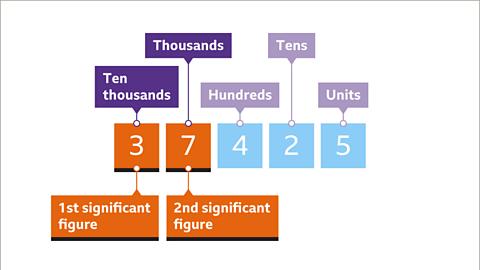
Image caption, For the value of 37,425 – the digit with the highest place value is 3, so this is the 1st significant figure. The digit 7 has the 2nd highest place value in this number, so the 2nd significant figure is 7
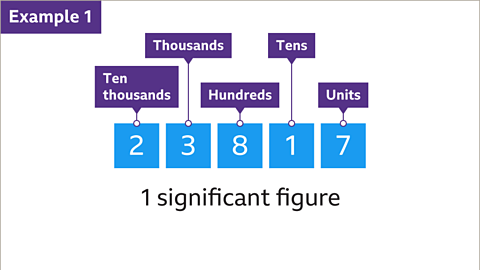
Image caption, Round 23,817 to 1 significant figure.
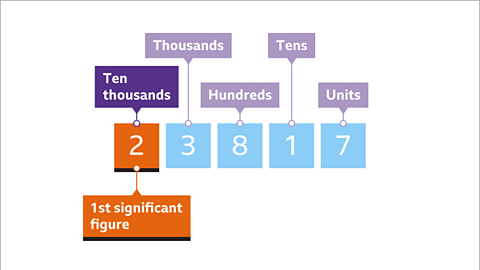
Image caption, The digit 2 has the greatest place value. This is most significant value and represents the 1st significant figure. It is positioned in the ten thousands column, so 23,817 is rounded to the nearest ten thousand.
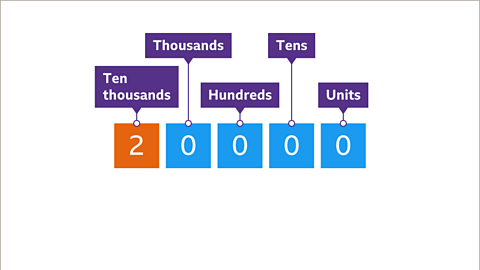
Image caption, The 2 is left the same because the next digit (3) is less than 5 (rounding down). The digits after the 1st significant figure are replaced with a zero. 23,817 rounded to 1 significant figure is 20,000
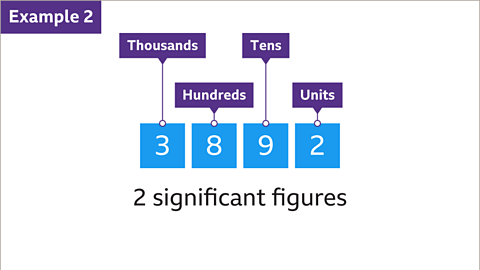
Image caption, Round 3892 to 2 significant figures.
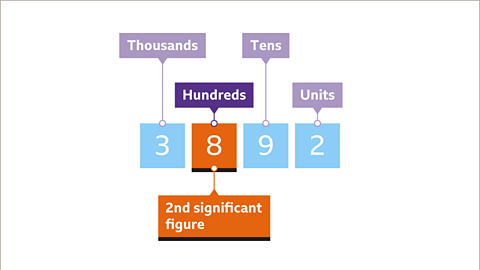
Image caption, The digit 3 has the greatest place value. The digit 8 represents the 2nd significant figure. The digit 8 is positioned in the hundreds column, so 3892 is rounded to the nearest hundred.
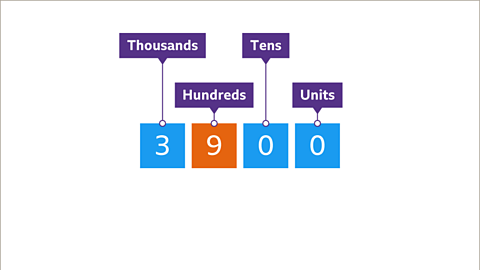
Image caption, The digit 8 is rounded up to 9 as the next digit (9) is 5 or more (rounding up). The trailing digits after the 2nd significant figure are replaced with two zeros. 3892 rounded to 2 significant figures is 3900
1 of 7
Question
Round 241,529 to 1 significant figure.
In the number 241,529, the most significant figure is the 2
This is in the hundred thousands place value column.
241,529 rounded to 1 significant figure is 200,000
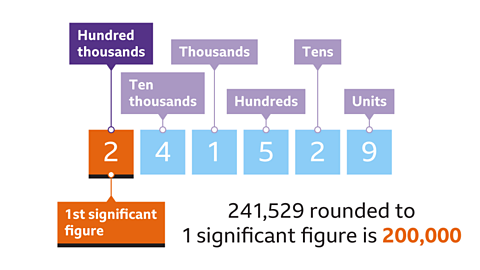
Rounding small numbers using significant figures
- Significant figures start at the first non-zero number, so ignore the zeros at the start of the number, but not the ones in between.
- Once the most significant figure has been identified the same rules of rounding are applied.
- From the first significant figure onwards, all zeros are included. It's only the zeros at the beginning that don't count.
Examples
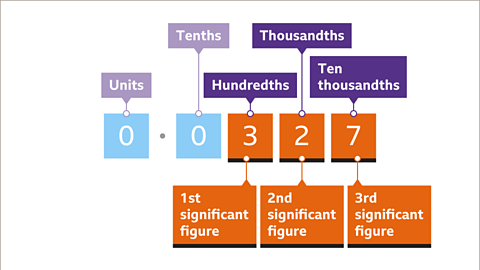
Image caption, For the value of 0∙0327, the digit with the highest place value is 3. This is the 1st significant figure. Ignore the place value columns at the beginning containing zero. The 2nd significant figure is the digit in the next place value column which is the 2. The 3rd significant figure is 7
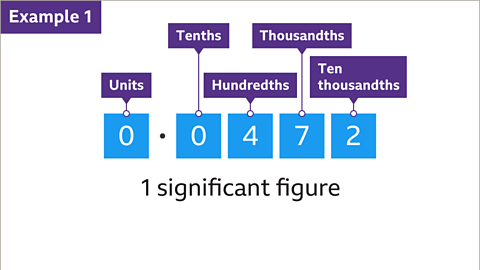
Image caption, Round 0∙0472 to 1 significant figure.
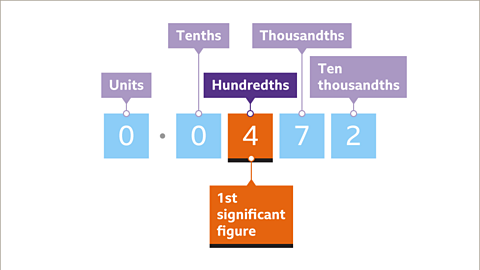
Image caption, The digit 4 has the greatest place value. This is the first non-zero digit in the value. The 4 is the most significant value and represents the 1st significant figure. The digit 4 is positioned in the hundredths column, so 0∙0472 is rounded to the nearest hundredth. The 4 is rounded up because the next digit (7) is 5 or more.
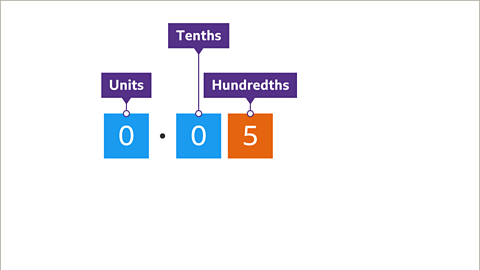
Image caption, The 4 is rounded up to 5. No further digits are included after the 5
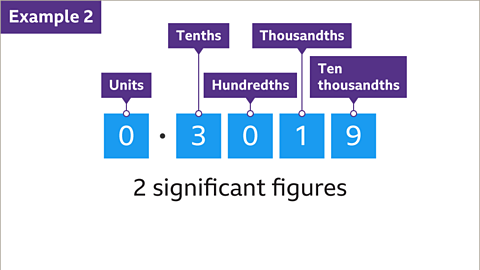
Image caption, Round 0∙3019 to 2 significant figures.
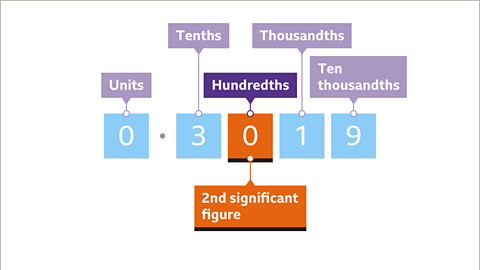
Image caption, The digit 3 has the greatest place value and is the first non-zero digit in the value. The digit zero represents the 2nd significant figure. The 2nd significant figure is positioned in the hundredths column, so 0∙3019 is rounded to the nearest hundredth. The 0 is left the same because the next digit (1) is less than 5 (rounding down).
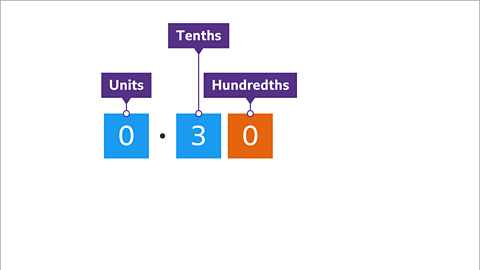
Image caption, There must be two significant digits in the final answer so one zero following the 3 must be included. 0∙3 would have only been rounded to 1 significant figure. 0∙3019 rounded to 2 significant figures is 0∙30
1 of 7
Practise rounding numbers using significant figures
Practise rounding numbers using significant figures in this quiz.
Quiz
Real-world maths
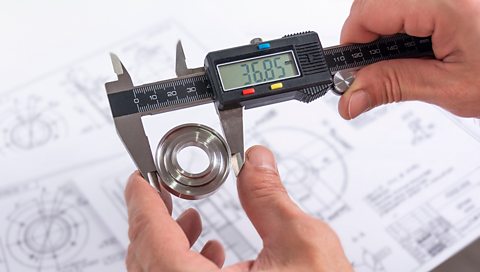
- Rounding using significant figures is useful when dealing with extremely large or small numbers where rounding using other methods is not always appropriate.
- An engineer may round a measurement to 2 or 3 significant figures because they can’t measure any more accurately.

Game - Divided Islands
Play the Divided Islands game! gamePlay the Divided Islands game!
Using your maths skills, help to build bridges and bring light back to the islands in this free game from BBC Bitesize.

More on Rounding and estimating
Find out more by working through a topic
- count5 of 6

- count6 of 6
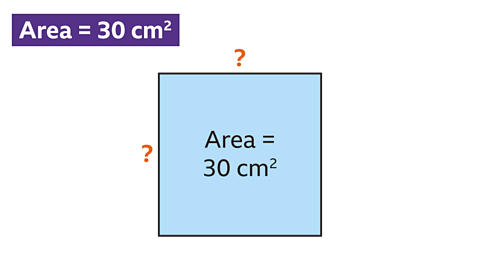
- count1 of 6

- count2 of 6
